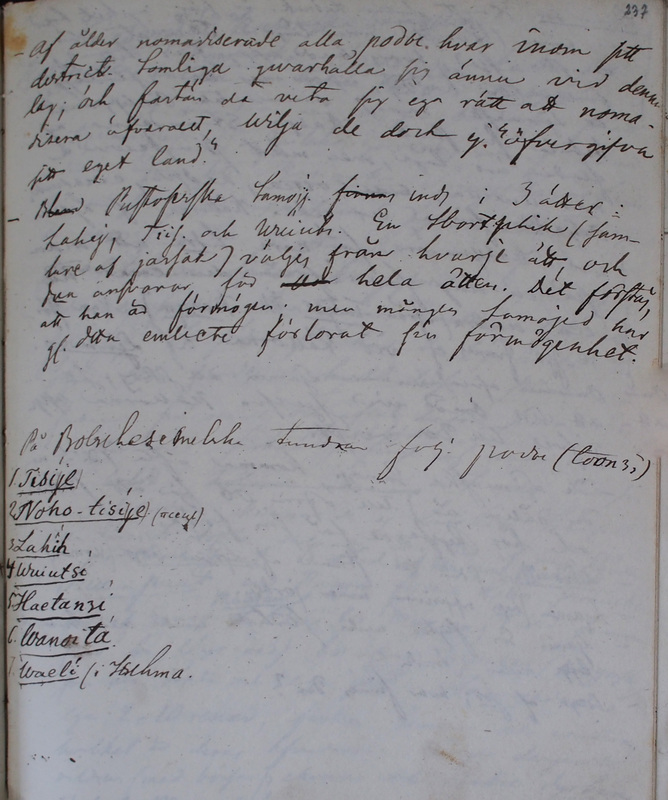Ethnographiska, historiska och statistiska anmärkningar. 237
Title
Ethnographiska, historiska och statistiska anmärkningar. 237
Description
| Af ålder nomadiserade alla роды hvar inom sitt district. Somliga qvarhålla sig ännu vid denna lаg; och fastän de veta sig ega rätt att noma disera öfverallt, wilja de doch ej "öfvergifva sitt egen land.”
Despite constant movement, pastoralists attach their belonging to certain lands or landscapes, which the Nenets relate to their family histories (Lehtisalo 1932: 91; Stammler 2005: 231–234).
|
Since the old days, all family groups have nomadised within their own district. Some still hold on to this law; and although they know they have the right to nomadise everywhere, they still do not want to “give away their own land”. |
| Bland Pustozerska Samojj. finnas ind.[indelas]
i 3 ätter:
Here, Castrén relates the TN тенз to the Swedish ätt, which is translated as ‘tribe’. Other categories related to family, way of life, and religion are TN еркар and нгэсы. They were used variably in relation to the Russian administration, which is why their meaning also varies according to the time and place. While нгэсы ʻcamp’, clearly relates to an economic unit based on familial ties, it is unsure whether еркар and тэнз mean different things and what the difference between them might be. Both seem to be larger familial units, and Soviet ethnographers divided them into two fratries (Вануйта and Харючи), which, according to them, developed in the course of history into subcategories, the Тысыя, Лэхэ, Выуци, and Вэли. Castrén’s data seems to follow the same lines. See also [роды] (Dolgich 1970: 23; Chomič 1966: 141–158; Vasil’ev 1979: 75–85, 134–156.)
Lahej, Tiis. och Wuiuh. En Sbortsschik
(sam-See [starschina].
lare af jassak) väljes från hvarje ätt, och dna[denna] ansvarar för hela ätten. Det förstås, att han är förmögen; men mången Samojed har ge. [genom] detta embete förlorat sin förmögenhet. |
The Pustozersk Samoyeds are divided into three tribes: Lahej, Tiis, and Wuiuh. A collector of jasak is chosen from each tribe, and he is responsible for the whole tribe. It is understood that he is wealthy, but many Samoyeds have lost their fortune because of this work. |
| På Bolschesemelska tundran följ[ande]. роды (toonzì) 1 Tisi'je
Тысъя. One of the six main branches of the European Nenets families (Dolgich 1970: 9–10; Chomič 1976: 108).
2 Noho-tisí(je)
(псець)Nocho-tissij. Corresponds to TN Нохо’ Тысъя, fe. Нохоʹ Тысъиʹ; also Ноготысыи. A branch of the Тысъя family (Dolgich 1970: 9–10; Chomič 1976: 105; Tereščenko 2003: 683). As Castrén notes, TN нохо ʻarctic fox’.
3 Lahîh
Lachi, also Logej, Lècheci, Lagejskoj, Lochejsskij. Corresponds to the TN family Лэхэ, fe. Лэхэй; also Лагейскойʹʹ. (Chomič 1966: 151; Chomič 1976: 105; Tereščenko 2003: 170, 206)
4 Wuiutso'
TN family Выуци or Вууци. (Chomič 1966: 151; Chomič 1976: 103; Tereščenko 2003: 63.)
5 Haetanzi'
TN Хэтанзи. one of the six main branches of the European Nenets families. (Chomič 1966: 151; Chomič 1976: 110; Dolgich 1970: 9–10.)
6 Wanoita'
Ru Vanujta. Also Vanjuta, Vanojta. TN Ванойта, fe. Ванойʹ, Ванойтиʹ or Ванюта represents one of the six main branches of the European Nenets families. It has also been suggested to represent one of the exogamic groups of the Nenets, the other being Харючи. (Chomič 1976: 102–103; Dolgich 1970: 9–14; Tereščenko 2003: 41–42)
7 Waelí
(i Ischma)Вэли represents one of the six main branches of the Nenets families. Again according to Chomič, the Вэли are a sub-branch of the Vanjuita. (Chomič 1976: 103; Dolgich 1980: 9–10; 55–59; Tereščenko 2003: 38)
|
In the Bolshezemelskaja tundra there are the following family groups (toonzì): 1 Tisi'je 2 Noho-tisí(je) (Arctic fox) 3 Lahîh 4 Wuiutso' 5 Haetanzi' 6 Wanoita' 7 Waelí (in Ižma) |

